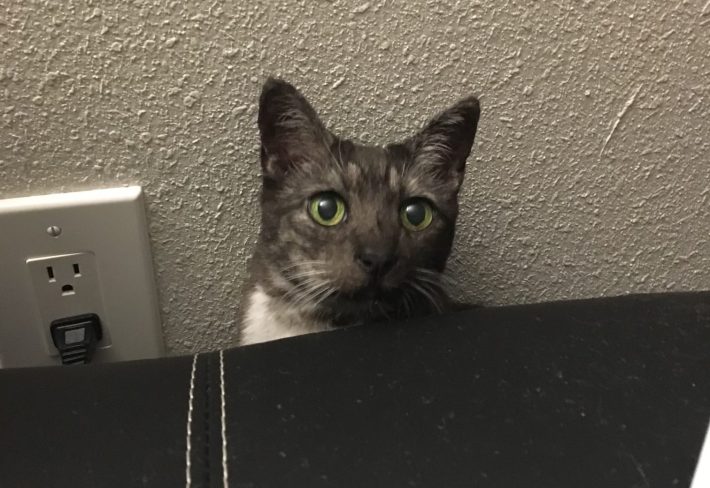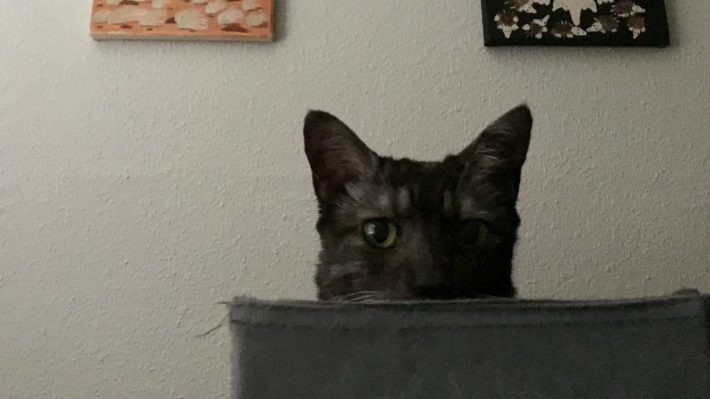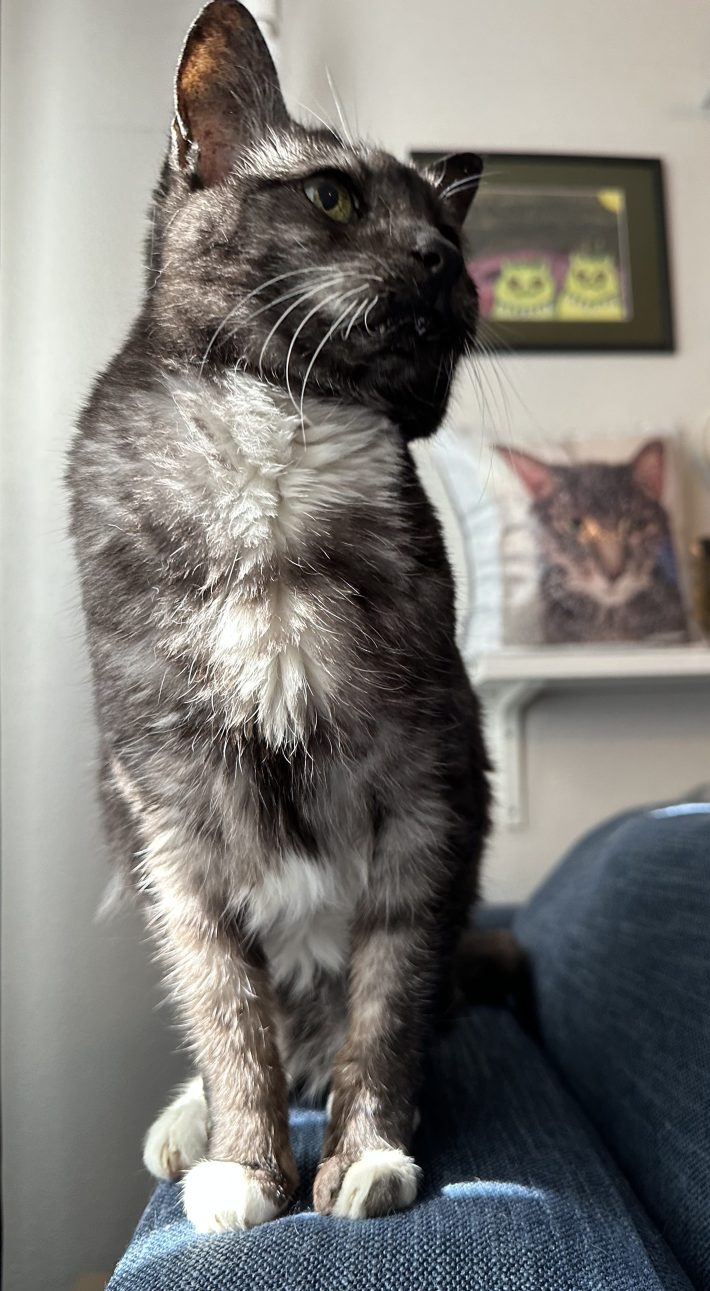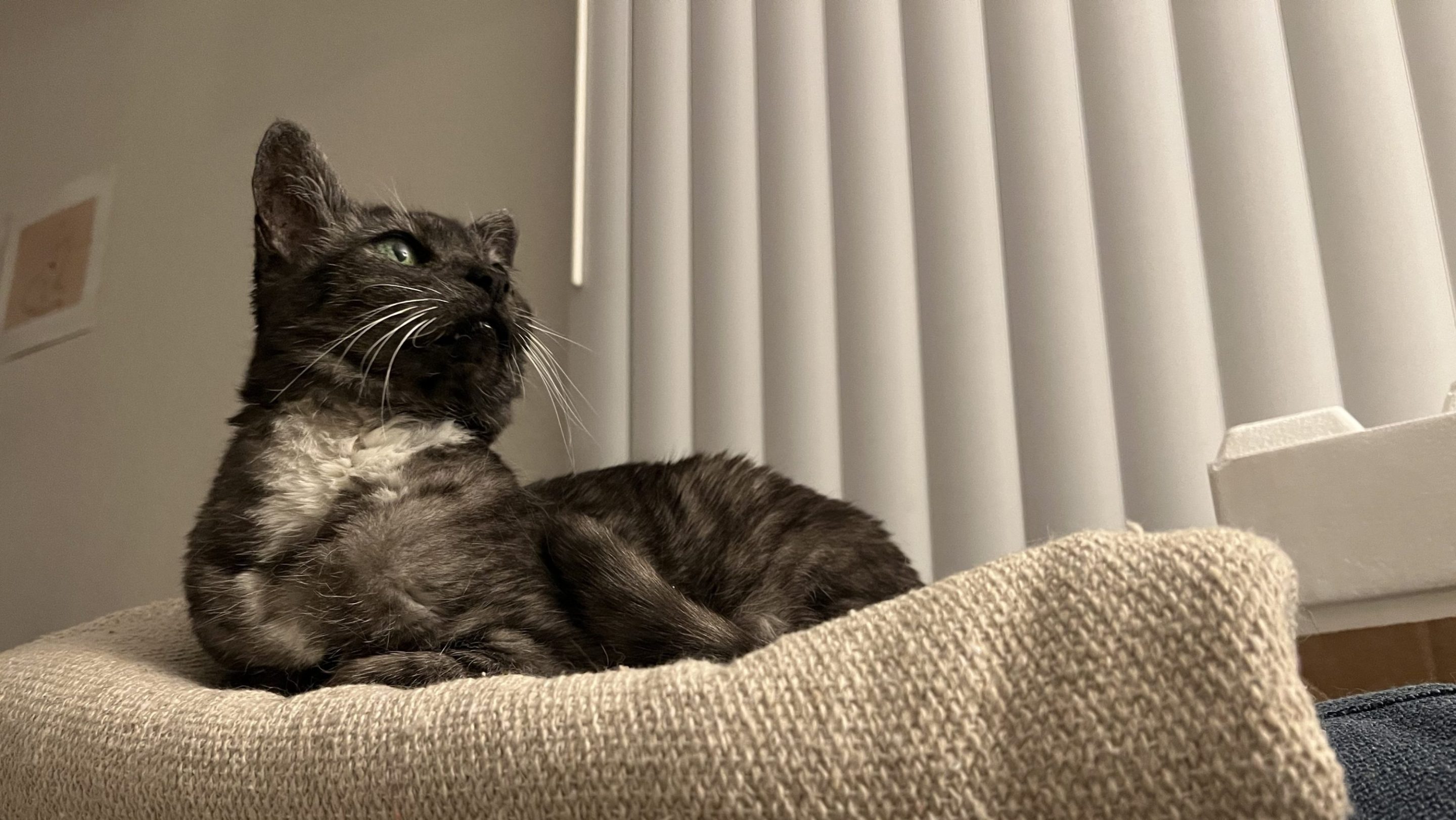I didn't see much of Lilly for the first five years of our life together. Or maybe it was four or six or some other number. I wasn't really counting. In the pre-smartphone, pre-social media world, tracking every single data point of our lives wasn't how we lived just yet. Entire chunks of life would pass by un-tallied, un-photographed, and without notice. Besides, Lilly's mysterious ways seemed fairly harmless, what with her being a cat.
I adopted Lilly after already having one cat foisted upon me by the Miami Herald's Broward bureau: a gray tabby who I named Katharine Graham. She was found stuck in a bush by a coworker who had gone home to walk her dog on her break. She did as you do in newsrooms, or at least the Herald's, where whatever stray detritus you stumbled upon out in the field—mangos, starfruit, pastelitos, a kitten—got brought into the office. I arrived one day, back from a press conference for something or other, to see a brown box on my desk, and inside it a little gray kitten sitting atop a bed of shredded newspaper. The newsroom had decided she was my kitten now. Who was I to say no? I named her Katharine Graham because she needed a newsroom name, and Lois Lane seemed too obvious.
Within a few months, it became clear that Katharine Graham needed a buddy to play with while I worked, and another coworker, who fostered cats, suggested Lilly. I would like to tell you that I thought deeply about this decision—Is she the right fit? Does she have the right temperament? Do they complement each other?—but I did not. I said sure, came by to pick up Lilly, and tossed her into our lives.
OK, I did not literally toss. When integrating new cats into a home, the advice is to keep the new cat in a separate room for a while and then slowly introduce them to each other by having them eat on opposite sides of a door, exchange their scents, and only gradually establish physical contact. I decided to keep Lilly in the bathroom, except the arrangement lasted a few days because Lilly did not want to live in the bathroom. I did my best to keep her in, afraid she'd tussle with Katharine Graham, but one day when I opened the door, she shot out like a cannonball and flew underneath the bed, where she stayed. And stayed. And stayed. I fed her dry food under the bed because she would not move.
She lived like this for I don't know how long. Sometimes I would glance under the bed, see those bright green eyes glaring back at me and figure, well, she's still alive so that's a win. Sometimes Katharine Graham would sit on the floor by the bed and also watch her new, adopted sister with a quizzical look that scanned to me as: This new cat is so weird, but she lets me be in charge so it's fine. Lilly did appear to be eating and drinking water, just not when I could see it. She definitely used the litter box; there was no question about that. I could even hear her playing with Katharine Graham at night as I fell asleep and they ran laps around the living room. Every morning I would wake up, see what furniture they had sent askew (my poor desk hutch never stood a chance), fix it, refill their food and water bowls, then go about my day with Katharine Graham buzzing around my feet and Lilly nowhere to be found.
Occasionally friends would come over and I'd pull Lilly out from under the bed, eight pounds of quivering fur, giant eyes bulging with fear, and using all her strength to squirm out of my arms—which is to say, this would work just long enough for me to say, "Look, I really do have another cat!" before she flew into the air, crash-landed, and bolted back under the bed. She's so beautiful, people would tell me, with her unique, smokey coloring, white bib, and green eyes. It's such a shame she's so afraid for her life all the time. They'd also wonder about her breed; I'd tell them Tamarac parking lot.
People would also ask if me I thought this setup was weird, and I genuinely did not. She played with Katharine Graham and she was generally well-behaved. She ate, she drank, she pooped. I wished she'd cough up fewer hairballs but no cat was perfect and, besides, Katharine Graham demanded so much attention—she purred to the touch—that I figured the two of them averaged out to one normal cat.
Lilly slowly emerged from her shell, though slow doesn't really describe it. Molasses rolls down a kitchen counter faster than Lilly got over her fear of every single human on Earth. But she did start appearing during the daytime—always at the other end of the room, as far away as possible, and ready to hit the gas the moment she heard her name, let alone if I moved. That's how I took to calling my cats Miss K and Miss L: it was so I could talk about them on the phone without Lilly having a heart attack.
But nothing contributed to Lilly's progress quite like Mr. Diana moving in. (Mr. Diana does have a real name, but it's a fairly common one and adds nothing to the story.) Mr. Diana never "officially" moved in. It was more like, after three years of dating long-distance, he decided to move back to South Florida, I told him that he could crash with me, and then I never told him to leave. He just stayed. A lot like a cat in some ways. He also, as a lifelong and very proud cat guy, decided to make it his mission to bond with Lilly. (Katharine Graham was what the vet would call "food-motivated" and bonded with every human who fed her, so she was not a project.)

At this point in time, Lilly was in her water heater phase, when she spent most of the day asleep atop the water heater in the back of the closet. Seeing how this was not under the bed, I considered this progress. But Mr. Diana got in the habit of, every day, going inside the closet, wiggling himself into that tiny corner, and spending time petting Lilly. Did I give this much thought? Once again, the answer is no. I figured there were worse ways for a man to spend his free time, which I knew for a fact because I spent my days as a news reporter writing about the many horrible outcomes of the ways men spend their time.
Over time, Lilly emerged more and more. This evolved from only being across the room from us, to being halfway across the room from us, to eventually being near us, to sometimes even sitting on the futon with us, though always on the opposite side.
But her dedication to hiding never faded. Hiding was Lilly's one true north star, her guiding light, her divine philosophy. That's how we almost lost her in West Texas.
In early 2013, Mr. Diana and I moved about 3,000 miles from Fort Lauderdale to Los Angeles. One of our overnight stops was in Fort Stockton, Texas, home of the second-tallest road runner statue in the world. Before the move, I was advised to keep my cats in the bathroom overnight so they couldn't hide, but Katharine Graham would yowl as if the world was ending, so in each new hotel room we did our best to close up or at least clog with towels any potential hiding spaces for Lilly. Every night until Fort Stockton, this worked.
We turned up everything. We moved the nightstands and the bureau. We opened all the drawers. We looked under the bed. No Lilly. Though we'd put out the "do not disturb" sign, we convinced ourselves that somehow housekeeping had entered our room and Lilly had darted outside into the desert, so we walked around the premises with open cans of wet cat food, hoping the smell would draw her back in. (We also glared at Katharine Graham, who offered no clues at all.) I do not doubt that we looked like damn fools and all I could think was, "If we don't find this cat, me and my boyfriend are definitely breaking up because we're gonna blame each other."
Defeated and emotional, Mr. Diana called the La Quinta's front desk and asked if anyone had spotted a black and white cat because ours was missing. Oh, the woman at the other end replied, she must be stuck in the box spring. I'll send maintenance over there to get her out. Sure enough, the maintenance worker came over and, as soon as he lifted up the box spring, we could see through its gauzy bottom a tiny ball of black fur tumble down to the bottom. The man cut a slit in the fabric with a box cutter, pulled out Lilly, and handed her to Mr. Diana. He even said not to be too mad at ourselves, explaining that this had happened several times before.

We eventually made it to L.A., and Lilly climbed out of her shell a little bit more in her new home. She developed a passion for jumping up on the bed and snuggling with Mr. Diana for a few minutes before he got up. Sometimes, she would even emerge and let strangers view her from a distance—a far distance, but still. Yet even a more social Lilly never stopped scaring us with her deft hiding abilities. Mr. Diana once again thought he lost her in another hotel room a few years later when we had to be out of our apartment for 24 hours (she was, of course, in the room the whole time). Whatever the most remote, darkest, hardest-to-reach corner of any space, she would find it, wedge her tiny body in there, and never make a peep. In fact, she spoke so infrequently that Mr. Diana would record audio files of when she did, as proof she could talk. This happened about twice a year.
Everything changed when Katharine Graham died. Before, she had been my cat—the adventurous one, the social one, the charming one, the one I picked up every morning and gave a big, squishy hug—and Lilly was Mr. Diana's. Our first day without Katharine Graham, I picked up Lilly and she squirmed out of my arms right away. Of course she did. I cried anyway.
People told us to get another cat, but I said no. Lilly had spent her entire life crowded out: first by her fellow ferals in the cat colony, then among her fellow foster cats, and finally basking in the powerful glow of Katharine Graham. She'd never been in charge. I thought maybe she'd like it. Besides, at age 16ish (with street cats, it's all a little made up), how much longer did she have? Six months? A year?
She had three and a half more years. And perhaps the strangest part of all was what she did with those final three and a half years. She emerged from all those years of hiding and shone. Lilly began talking, a lot, and then so much we worried our neighbors would complain because the voice she had been holding back all those years was almost ear-splittingly loud. She used her voice to make demands: she must chase a sunbeam every morning, chase mousey on the fishing pole every early afternoon, and probably chase laser pointer later on the afternoon if the mood struck her. She meowed for food and yowled for attention and made the strangest eeek-eeekkkk-eeeeekkkkk sound when she got the zoomies. From atop her cat tree, she swiped at either of us as we passed by, trying to egg us on to play even more. (This was the only time she ever swiped at a human. Katharine Graham, on the other hand, wielded her claws like daggers.)

One day a maintenance worker came over and Lilly, for the first time ever, did not hide. She stood there in the hallway and, when the worker knelt down, she let him pet her. Ooooohhhhhhh ... what a sweet kitty! he told us. Yes, we replied, while we stood there in shock. Who was this cat? Was she ours? Can cats, uh, body swap? The cat who once hid under the bed now stormed into the living room and demanded our attention and grandly interrupted any Zoom meetings or phone calls. Sometimes I could even hold Lilly for a whole 30 seconds which, yes, she didn't love, but she learned to tolerate it, which was the most I could ask of her.
The last few years with Lilly weren't always this idyllic. She required medication every day, twice a day, for nearly a year, and as brave as she was she still hated medicine. Her final months were only made possibly by monthly injections of monoclonal antibiodies for her osteoarthritis. During those months, we were so hyper-aware of her every need, we didn't leave her alone for more than a few hours at a time—and we barely even did that. When friends asked how I was doing to start 2024, I'd joke that in my free time I ran a cat hospice.
Her final months also saw Lilly doing the one thing I swore she'd never do: Sleep with us on the bed, all the way through the night. The fraidy cat, in her final months, became the bravest girl, which at times proved deeply annoying when she just barely cleared jumps she should not have been trying in her condition, but at night, with my arm wrapped around her, I thought perhaps she really was my cat, or at least as much my cat as any cat can belong to a human being.
She died peacefully at home earlier this year, surrounded by all her favorite toys and her two humans who at last did not scare her. Whereas Katharine Graham's departure happened in an instant, Lilly took her time. I joked that Lilly lived so long because, as a fraidy cat, she'd see the light and run in the other direction. Near the end, all I wanted to tell her was: Lilly, I promise the light isn't that scary.
If you liked this blog, please share it! Your referrals help Defector reach new readers, and those new readers always get a few free blogs before encountering our paywall.
Investigations Editor. You can reach her at diana@defector.com or, if you prefer protonmail, dfmoskovitz@protonmail.com. If security is a concern, download the Signal app and send her a text at 929-251-8187.
Read More:
Stay in touch
Sign up for our free newsletter






